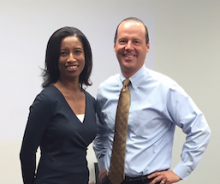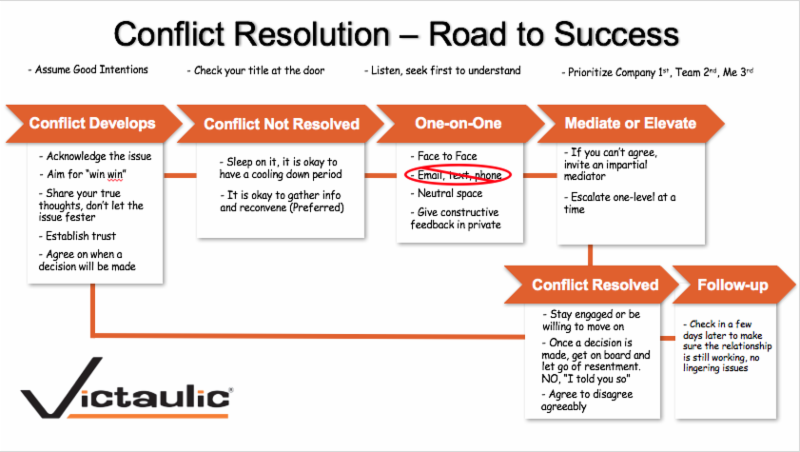At Victaulic, a manufacturing and engineering company with 3,600 employees across the globe, collaboration is the key to creating a culture of innovation.
That's why Rick Bucher, Executive VP of Technology & Product Development, teamed up with Carolyn Stennett, VP of Human Resources, to create an ongoing focus on team development."There's so much happening now -- the workforce, the workplace, and the business environment is constantly changing," says Stennett. "The way we do work -- how we work -- has been evolving and moving away from hierarchical organization.
"We now collaborate and work across different functional groups. There are big opportunities, global issues -- and unless we connect across the organization, we're not going to stay ahead of the curve."
The Benefits & Challenges of Collaboration
Determined to remain the world's leading producer of pipe joining solutions, Victaulic's Product Development Department created a unique structure with different functional groups all co-located together. Instead of the top-down culture of 20 years ago, executives like Rick Bucher value how collaboration drives innovation now.
"You may think you know how something should be done," says Bucher. "But when you give a problem to a team and let them come up with the solution, they come up with something that you never thought of -- that's probably a lot better than what you would have thought of on your own. And because they own the solution, they're engaged. They feel that passion of, 'This is my baby and I want my baby to thrive.'"
Ownership. Engagement. Passion. The benefits of collaboration can be huge -- and so too are the challenges of creating teams that work well together.
As part of their ongoing efforts to establish a culture that maximizes innovation and minimizes organizational conflict, Rick and Carolyn brought in Shawn Kent Hayashi and Melanie Sanchez-Jones to conduct a high performing team retreat.
The impact? According to Stennett, learning how people have different behavior styles has helped team members see each other differently. "Before the retreat, it was easy to dismiss someone for not being a 'team player' without really understanding their approach. Now people have a framework for understanding how others operate, which helps them avoid taking some behavior personally.
"I think one of the biggest benefits from the team retreat is having everyone appreciate that we come at our work through a different set of lenses. We get to the same place, but we get there in different ways. So another important outcome is that people have permission to process their thinking in a way that works for them."
A Team-Created Process for Conflict Resolution
While awareness of communication styles does minimize conflict, it doesn't eliminate it, which is why Shawn Kent Hayashi and Melanie Sanchez-Jones worked with the team to create norms for handling the friction that can arise when different perspectives collide.
In the weeks after the retreat, volunteers transformed the team-created document into a flow chart for how to work through tension and disagreement. This visual now hangs in every engineering conference room and every team member received a laminated copy.
"We do have conflict," Bucher notes, "and we want conflict. Our retreat document helps us all stay focused on how we have productive conflict that will help us innovate."
Measurable Results
Having team-created norms for working through organizational strife was just one of the many positive outcomes from the high performing team retreat. Rick has also seen "dramatic turn-arounds" in some high performing members of his team.
"I've seen some people really embrace the principles we talked about at the retreat. They have been able to recognize a need to rein in their own tendencies for stepping on other people's toes, and it's had a positive impact. Team members are more engaged. They look happier. And other people have even come to me to say, 'So-and-so' is a better collaborator.'"
The impact of the retreat is, in fact, measurable. Using their own criteria for what it means to be a high performing team at Victaulic, The Professional Development Group asked the team to evaluate its progress through a quarterly survey. The survey not only provides feedback on what's going well and what still needs improvement, it also refocuses people on their commitment to work better together.
"The survey helps make the work of the retreat an ongoing process," Stennett observes. "It's not a one-and-done experience. We're really pleased with the results of the second quarter follow-up survey. Now there's a common language, a common experience that people can use to hold each other accountable. It's not just coming from the leadership; it's coming from colleagues."
Is this focus on creating a more collaborative culture making a difference? Stennett thinks so.
"Bringing different voices to the table and ensuring we're hearing from everyone can be challenging. But at the end of the day, we get further with our products. It's incredible the amount of innovation that has come out of these teams."
Already a successful global company, Victaulic continues to grow and adapt to the speed of a changing marketplace and a changing workforce.
The key to Victaulic's success? Leaders like Rick Bucher and Carolyn Stennett who are focused on creating the right culture for innovation -- a culture that attracts and retains the best talent with a collaborative structure and ongoing professional development.
Rick and Carolyn are building the future! Are you?




